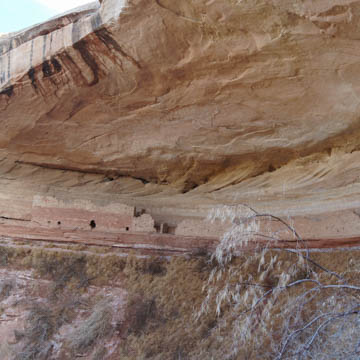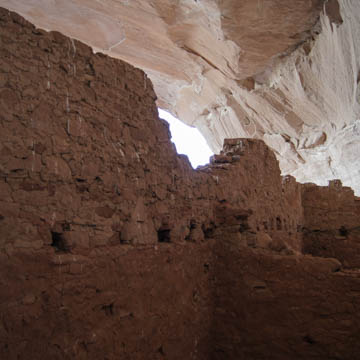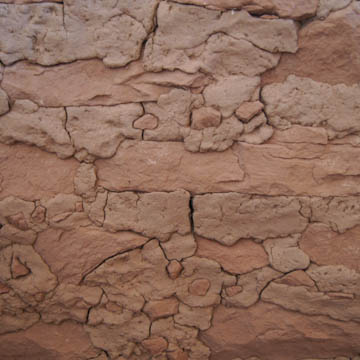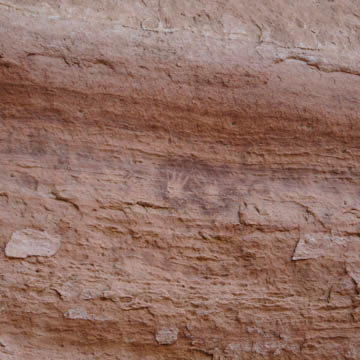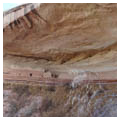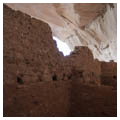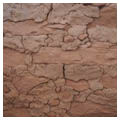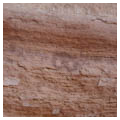You are here
Sixteen Rooms House
Sixteen Rooms House, also known as Casa del Eco, is named for the number of existing demarcated spaces in the ruin. It is an excellent example of a Pueblo III cliff dwelling built by Ancestral Puebloans in the twelfth century, showcasing the functional elements of a dwelling and how it was integrated into landscape.
The house is located in southeastern Utah, across from the town of Bluff, along the San Juan River. Protected from elements, the house has not required excavation in order to learn more about the original inhabitants and building. Its ruin is tucked into a grand alcove on a steep cliff, at least sixty feet above ground level. Nestled into the alcove in a single bay, the builders erected rooms on a single sweeping ledge, a broad C-shape plan with a single entryway; one had to move from room to room to traverse the house. The floor and the back wall of the rooms were made out of natural rock, whose surface was left uneven.
Only four of the sixteen rooms were large enough for human occupation. Two of these were on the ground floor, while the other two were built on top of them. The largest room in the house was only 5 x 8 feet, with a manmade pit in the floor. Off-centered and four inches deep, specialists believe this pit was either used for grinding corn or making fire. These bigger rooms show signs of fire damage, suggesting that they were used for sleeping and cooking. The partition between the first and second floor was made of rough wood. The wood pieces rested at one end on a natural or installed rock shelf and at the other three ends on walls built of roughly finished sandstone. The masonry features the striations of limonite (a yellow iron oxide mineral) and hematite (a rusty red iron oxide) that runs through the cliffs. The colored veins running through the rocks continued in the walls in a way that camouflaged the house in plain sight. It also suggests that the sandstone for the walls was possibly chipped from the alcove itself.
The rest of the twelve rooms were too small for sleeping or cooking. On average measuring 3 x 5 feet, they were probably used for granaries. Miniature corncobs left from the time of last use, scattered in one of the rooms, suggests the functional and hierarchical organization of the house. The mortar for this dwelling was made of clay, straw, wood chips, and smaller stones; stone chips reinforced the thick, uneven layers of mortar. The extant walls stand witness to the strength and effectiveness of the materials and building technique. High on the natural alcove, a series of adult and child handprints are on the walls. Since there is little evidence that the building exceeded two stories, it is not clear how occupants managed to create prints at such height; they might have used ladders or scaffoldings found in similar sites.
As was common in the twelfth-century San Juan region, the dwelling has small doorways and openings. The entrance is accessed through small steps carved into the stone. The lintel above these steps is no higher than 2.5 feet. If this is considered the “front entrance,” it means that occupants had to bow down and crawl in and out on their knees. This mode of entry is also found at Hovenweep and other cliff dwellings like Moon House; it slowed down entrants and deterred intruders. The manmade wall on the front of the structure contains specially placed peepholes, similar to other ancient ruins in the Pueblo III time period. Some of them allow views to the left and right of the alcove, while others inspect the valley below.
Compared to most cliff dwellings that face south to take advantage of sunshine in the winter, Sixteen Rooms faces north. It looks toward the San Juan River, and surveys the vast flatlands surrounding it and the mesas across the river. The decision to occupy a north-facing alcove was likely guided by the precise visual and fortifying connection it afforded with the network of cliff dwellings and the sacred mesa with seven kivas across the river. Although the lack of sun and exposure to high winds would have made Sixteen Rooms inhospitable in winter, the deep and elevated cavity in the cliff would have provided a cool environment during the summer months; for this reason, it is possible that Sixteen Rooms was occupied only in summer.
References
Allen, Martin Lu, and Shane A. Baker. Of Earth, Stone, and Corn. Provo, UT: Brigham Young University, Museum of Peoples and Culture, 2000.
Writing Credits
If SAH Archipedia has been useful to you, please consider supporting it.
SAH Archipedia tells the story of the United States through its buildings, landscapes, and cities. This freely available resource empowers the public with authoritative knowledge that deepens their understanding and appreciation of the built environment. But the Society of Architectural Historians, which created SAH Archipedia with University of Virginia Press, needs your support to maintain the high-caliber research, writing, photography, cartography, editing, design, and programming that make SAH Archipedia a trusted online resource available to all who value the history of place, heritage tourism, and learning.

